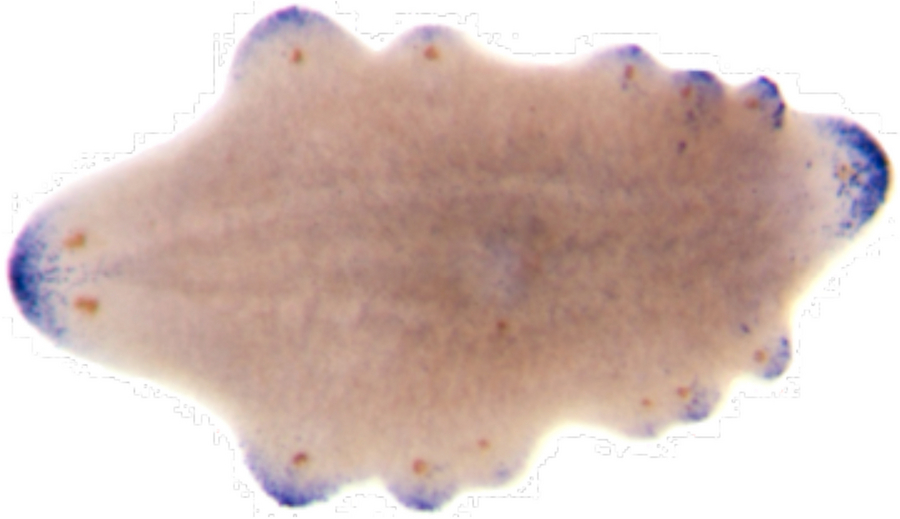
If the beta-catenin gradient is eliminated, the head system can activate anywhere in the animal. This results in the sprouting of new heads all along the perimeter of the animal. The image depicts one such multi-headed “monster”, with blue staining and the orange colour of the eyes highlighting individual head lets.
Flatworms can repair any injury and re-grow lost body parts or organs over the course of a few weeks. To this end, the stem cells of planarians need a molecular coordinate system that defines an anterior-posterior axis. Researchers at the Max Planck Institute of Molecular Cell Biology and Genetics (MPI-CBG) in Dresden now demonstrate that a mutual antagonism between two self-organizing patterning systems define a head-tail axis.
Planarians are known for their excellent regenerative abilities and thus a popular model species in regeneration research: If you cut the worm into two pieces, both halves will regrow the right counterpart – the head a tail, and the tail a head. The worm can even be cut to 200 pieces, and 200 new worms will regenerate from each and every piece. As size and geometry can obviously vary, and as regeneration can be initiated from any random starting point, it has been a long-standing hypothesis in the field that a molecular coordinate system must underlie the body plan of planarians. A signaling pathway with the protein Wnt as source and ß-catenin as transcription factor was known to be associated with tail regeneration. The Dresden research team headed by Jochen Rink could now show that a Wnt gradient with high amounts of ß-catenin in the tail and decreasing levels towards the head patterns the expression of genes. Interestingly, the genes required for gradient establishment are themselves controlled by ß-catenin, which enables the gradient to literally establish itself at any point in the animal in an injury-dependent manner.
A second system uses a different gradient to send signals from the head – its components are not known. The two systems are functionally coupled by mutual antagonism and by regulating the expression of certain genes help to subdivide the planarian body along a head-tail axis. In case of an injury, this coordinate system can give important information to the organism about where the injury happened and where the starting point of regrowing tissues has to be localized.
Antibodies with a high affinity were needed in order to visualize and quantify pathway activity of ß-Catenin in the tissue during regeneration. „That was a major challenge during the project, the Antibody Facility at the MPI-CBG eventually managed to deliver what we needed,“ says Tom Stückemann, one of the first-authors who had performed most of the experiments of this study. The project was a collaboration with the Max Planck Institute for the Physics of Complex Systems and the Center for Advancing Electronics Dresden of Technische Universität Dresden. The results were published in Developmental Cell.
Tom Stückemann, James Patrick Cleland, Steffen Werner, Hanh Thi-Kim Vu, Robert Bayersdorf, Shang-Yun Liu, Benjamin Friedrich, Frank Jülicher, Jochen Christian Rink:
Antagonistic Self-Organizing Patterning Systems Control Maintenance and Regeneration of the Anteroposterior Axis in Planarians.
Developmental Cell, 6 February 2017